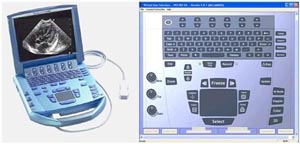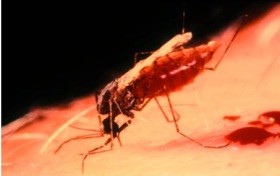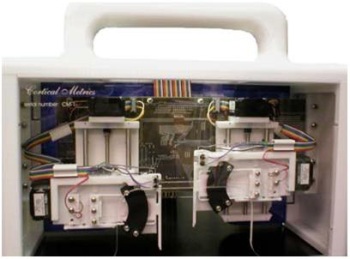


- Using Telemedicine to Get to the Heart of Neonatal Cardiac Disease
- Researching Alcohol Abuse and Dependence
- Search for New and Safe Antimalarial Drug
- Understanding the Role of PECAM-1 during Angiogenesis
- Measuring Cortical Interactions in the Autistic Brain
Using Telemedicine to Get to the Heart of Neonatal Cardiac Disease
Posted September 8, 2010
David J. Sahn, M.D., University of Oregon, Portland, Oregon
Echocardiography, or ECHO, refers to an ultrasound of the heart: Sound waves create a moving picture of the heart to allow diagnosis, evaluation, and monitoring of a variety of heart conditions. For example, ECHO may be used to evaluate congenital heart disease in infants. However, the expensive equipment and expertise required to perform and interpret neonatal ECHO results may not be available at remote healthcare facilities. Transporting an infant to another hospital for evaluation can cause distress for the infant and family, is time-consuming, and may be very costly. Dr. David Sahn, who received a fiscal year 2002 Investigator-Initiated Research Award through the Department of Defense Peer Reviewed Medical Research Program, hypothesized that "trained primary care practitioners or nurses can, with telemedicine supervision, successfully perform cardiac ultrasound exams on neonates at risk for heart disease and thereby impact time to diagnosis, improve outcomes, and decrease costs."
To conduct the study, termed Tele-ECHO, primary care practitioners and nurses at several participating rural sites were trained to perform and evaluate ECHO on neonates at risk for heart disease using standard ECHO machines and handheld, portable ultrasound scanners from Sonosite, Inc. A secure telemedicine network was installed and tested at the participating sites and linked to pediatric cardiologist specialists at Madigan Army Medical Center (MAMC). To date, this award has helped to train numerous physicians and nurses from remote healthcare facilities in Alaska and the U.S. Pacific Northwest on the Tele-Echo system. The Tele-Echo system allows for realtime cardiac ultrasound to be performed by trained medical staff at remote sites, while being supervised by experts in ECHO at Oregon Health & Science University (OHSU) or Madigan MAMC through voice and image transfer links on the Army medical network (MEDNET). The telemedicine MEDNET links also allow control of the scanning system settings by the experts at OHSU or MAMC. The project was conducted at three military installations in the U.S. Pacific Northwest and in Alaska, including a large Alaska Native Health Center in Anchorage.
Initial results from the Tele-Echo project indicate that telemedicine-implemented diagnosis positively affects outcomes in infants suspected of having congenital heart disease by primarily improving the quality and timing of care for the patient. Dr. Sahn's ultimate goal is to expand the use of this remote neonatal cardiac diagnosis concept to other military and civilian medical centers where access to pediatric cardiology expertise is hampered by distance.Left: SonoSite MicroMaxx® Ultrasound; Right: Screen Shot of MicroMaxx® Virtual User Interface on computer Publications:
Li XK, Mack GK, Rusk RA, Dai XN, El-Sedfy GO, Davies CH, Sahn DJ. 2003. Will a handheld ultrasound scanner be applicable for screening for heart abnormalities in newborns and children? Journal of the American Society of Echocardiography 16(10):1007-1014.
Links:
Researching Alcohol Abuse and Dependence
Posted August 2, 2010
Robert M. Bray, Ph.D., Research Triangle Institute
Military recruits are subject to the forced abstinence of alcohol during basic and advanced training periods, but little is known about alcohol abuse among military personnel post-basic training and post-advanced training or the factors that help explain abuse, in the form of heavy episodic drinking, during the post-training periods. Dr. Bray, Principal Investigator (PI) on a fiscal year 1999 Investigator-Initiated Award through the Department of Defense Peer Reviewed Medical Research Program designed a project to investigate this phenomenon and to clarify the role of the military environment in alcohol misuse as well as the contribution of personal background and risk/protective factors that may mediate the relationship. The study examined the extent of alcohol and tobacco use, and related problems, among junior enlisted personnel in the Air Force and Navy before they entered military service and after completing basic training. Results of the project provided information on the relative contribution of background factors and military service on the high rates of alcohol and tobacco use among junior enlisted personnel.
Analyses of alcohol use showed a rate of 43% heavy episodic drinking during the month prior to basic training, 16% by infrequent heavy episodic drinkers (five or more drinks per occasion at least once; four or more for women), and 27% by frequent heavy episodic drinkers (five or more drinks per occasion; four or more for women, at least once a week). Pre-basic frequent heavy episodic drinkers averaged 8 drinks per occasion and nearly 15 heavy episodic drinking days during the month. In contrast, heavy episodic drinking following basic training was substantially lower: 12% for infrequent heavy episodic drinkers and 9% for frequent heavy episodic drinkers. The rate of frequent heavy episodic drinking (27%) before joining the military was notably higher than the 18.5% among civilians in the same age group (National Survey on Drug Use and Health, Office of Applied Studies, 2006). Dr. Bray believes that this finding suggests that a disproportionate number of frequent heavy episodic drinkers may be self-selecting into the military and bringing potential drinking problems with them. Final results, supplemented with results from the 2005 Department of Defense Health Related Behaviors Survey, indicate that while the initial phases of military training sharply reduce frequent heavy episodic drinking, low post-basic training rates are likely to increase over time, but probably not to pre-military levels. The study suggests that once in the military individuals learn the regulations and normative expectations about alcohol use and reduce their heavy episodic drinking habits, especially in the early days of training after the drinking ban is lifted. Expectations and norms in the military regarding frequent heavy episodic drinking likely help to prevent rates from returning to pre-service levels.Publications:
Bray RM, Brown JM, Pemberton MR, Williams J, Jones SB, and Vandermaas-Peeler R. 2010. Alcohol use after forced abstinence in basic training among United States Navy and Air Force Trainees. Journal of Studies on Alcohol and Drugs 71(1):15-22.
Green KJ, Hunter CM, and Bray RM. 2008. Peer and role model influences for cigarette smoking in a young adult military population. Nicotine & Tobacco Research: Official Journal of the Society for Research on Nicotine and Tobacco 10(10):1533-1541.
Links:
Technical Abstract: Alcohol Abuse and Dependence Among Military Recruits
Search for New and Safe Antimalarial Drug
Posted June 2, 2010
Ai Lin, Ph.D., Walter Reed Army Institute of Research
Every year about two billion individuals are exposed to malaria - with 300 to 500 million new cases of infection reported each year worldwide - resulting in the deaths of approximately 1.5 million to 3 million people annually. The number of cases and subsequent deaths are expected to increase globally due to a lack of access to effective drugs and to increasing malaria-acquired drug resistance to the existing treatment options, such as chloroquine and pyrimethamine. Dr. Lin received a fiscal year 2005 Advanced Technology Award through the Department of Defense Peer Reviewed Medical Research program to explore optimization of imidazolidinedione (IZ) derivatives that are orally active with potential curative and prophylactic activity against the parasite that causes malaria. Medicinal chemistry efforts are focused on the synthesis of chemically and/or metabolically stable IZ derivatives in a search for compounds with a longer plasma half-life than the lead agents. Preliminary work produced new IZ derivatives with longer plasma half-life and greater effectiveness in mouse and Rhesus monkey models than the parent compound itself. Further studies indicated the new IZ compounds are nontoxic and may be effective in fighting certain malaria-causing organisms. Dr. Lin plans to further enhance the oral activity of these compounds and to expand the range of parasites affected by the compounds to encompass both blood and liver stage malaria.
Publications:
Sathunuru R, Melendez V, Kozar MP, et al. 2008. A facile one pot synthesis of 2, 4-diamino-6-substituted s-triazine derivatives. J Heterocycl Chem 45:1673-1678.
Guan J, Wang X, Smith K, et al. 2007. Malaria causal prophylactic activity of imidazolidinedione derivatives. J Med Chem 50:6226-6231.
Ohrt C, Jones L, Notsch J, et al. 2007. Review of Experimental Therapeutics Chemical Information System for all Compounds Active in Prophylaxis Animal Models. Am J Trop Med Hyg PB 52.
Patents:
Lin AJ, Zhang Q, Guan J, et al. 2006. 2-Guanidinylimidazolidinedione compounds and methods of making and using thereof. US Patent 7,101,902.
Link:
Understanding the Role of PECAM-1 during Angiogenesis
Posted May 6, 2010
Horace DeLisser, M.D., University of Pennsylvania
Disparate processes ranging from wound healing to tumor growth rely on the formation of new blood vessels, a process known as angiogenesis. Impaired angiogenesis can lead to delayed wound healing, whereas excessive angiogenesis contributes to the growth and spread of tumors. Therefore, correct regulation of angiogenesis is critical, and a better understanding of angiogenesis is crucial for treating a variety of diseases and disorders. Platelet endothelial cell adhesion molecule?1 (PECAM-1) is a transmembrane glycoprotein expressed on endothelial cells that line the circulatory microvessels and that are the central cellular actors during angiogenesis. However, the precise role of PECAM-1 during angiogenesis is not fully understood. During in vivo angiogenesis, endothelial PECAM-1 interacts with proteins it recognizes (ligands); this initiates intracellular signaling cascades that facilitate endothelial cell (EC) motility, without which angiogenesis cannot occur. Dr. DeLisser, Principal Investigator (PI) on a fiscal year 2004 Investigator-Initiated Award through the Department of Defense Peer Reviewed Medical Research Program, believed that these PECAM-1-dependent ligand interactions trigger PECAM-1 activation and subsequent association with the signaling molecule SHP-2. This process, in turn, was theorized to facilitate the recruitment of SHP-2 to the membrane surface where SHP-2 mediates cellular activities that enhance EC motility. Dr. DeLisser has found that administration of an anti-PECAM-1 antibody or the loss of PECAM-1 inhibits EC migration and blood vessel formation in animal models of angiogenesis. This effect occurs without impacting cellular proliferation or survival. He therefore believes that, based on these ongoing studies and other results, therapy targeted at PECAM?1 is likely to be well?tolerated. However, given the important role of PECAM-1 in the recruitment of white blood cells into sites of infection or injury, the PI believes that only human clinical trials will serve to establish the ultimate safety of anti-PECAM-1 therapy.
Publications:
Cao G, Fehrenbach ML, Williams JT. 2009. Angiogenesis in platelet endothelial cell adhesion molecule-1-null mice. Am J Pathol 175(2):903-915.
Fehrenbach M, Cao G, Williams J, et al. 2009. Isolation of murine lung endothelial cells. Am J Physiol Lung Cell Mol Physiol 296:L1096-103.
DeLisser HM. 2007. Targeting PECAM-1 for anti-cancer therapy. Cancer Biol Ther 6:121-122.
Cao G, Savani RC, Fehrenbach M, et al. 2006. Involvement of endothelial CD44 during in vivo angiogenesis. Am J Pathol 169(5):325-336.
DeLisser HM, Helmke BP, Cao G, et al. 2006. Loss of PECAM-1 function impairs alveolarization. J Biol Chem 281(13):8724-8731.
DeLisser HM. 2006. Vascular cell-cell adhesion. In: Encyclopedia of Respiratory Medicine, Laurent GJ and Shapiro SD (Eds.). Elsevier Limited, Oxford, United Kingdom 29-36.
Delisser HM. 2006. The role of the extracellular matrix in angiogenesis. In: Bronchial Vascular Remodeling in Asthma and COPD, Lazaar A. (Ed.). Marcel Dekker, New York 105-125.
Tzima E, Irani-Tehrani M, Kiosses WE, et al. 2005. PECAM-1, VE-cadherin and VEGFR2 cooperate to initiate the endothelial cell-specific response to fluid shear stress. Nature 437:426-431.
Link:
Measuring Cortical Interactions in the Autistic Brain
Posted March 9, 2010
Mark Tommerdahl, Ph.D., University of North Carolina at Chapel HillA number of neurological disorders including autism have been identified as, or are predicted to be, associated with abnormal connectivity between brain regions. Although the incidence of autism is on the rise, knowledge about the underlying mechanisms of this disorder is incomplete. Further, developing animal models in which to investigate the neurobiological deficits associated with autism is difficult as there are very few objective metrics of the performance of human subjects with autism that can guide animal model development. As such, Dr. Tommerdahl, who received a fiscal year 2006 Investigator-Initiated Research Award through the Department of Defense Peer Reviewed Medical Research Program, is focusing on generating novel measures that reflect differences in underlying cortical circuitry between control subjects and those with autism in order to obtain objective metrics that will facilitate the development of innovative animal models of autism. To accomplish this, Dr. Tommerdahl has designed and fabricated a portable two-point tactile diagnostic stimulator (TPS) that can be used for the assessment of cortical health in subjects with autism. The new device, known as the Cortical Metrics stimulator (CM-1), consists of two independently controlled stimulators, allowing stimuli to be delivered simultaneously to two distinct sites at different amplitudes, frequencies, and/or phases. In addition, the CM-1 automatically detects the skin surface, which provides a more efficient stimulus delivery.
To date, protocols for the operation of the CM-1, such as the two-alternative, forced-choice (2AFC) tracking procedure, have also been developed to facilitate investigations of spatial discrimination in human subjects. Assessment of the amplitude discriminative capacity of human subjects between two stimuli positioned at near-adjacent skin sites demonstrates that the performance of the amplitude discrimination task was significantly degraded when stimuli were delivered simultaneously and were near a subject's two-point limen (threshold). Subjects were, however, able to correctly discriminate between the amplitudes of the two stimuli when delivered sequentially at all inter-probe distances (including those within the two-point limen). In addition, studies focusing on the impact of local cortical-cortical connectivity on information processing in autism have been initiated. In these, the temporal order judgment (TOJ) and temporal discriminative threshold (TDT) were assessed in 10 adult autism subjects and 10 healthy control subjects in the absence and presence of synchronized conditioning vibrotactile stimuli. Data from this study indicate that delivery of simultaneous and synchronized vibrotactile stimuli to near-adjacent skin sites decreases a healthy subject's ability to determine temporal order, whereas autistic subjects do not demonstrate such a decreased capacity in TOJ in the presence of synchronized conditioning stimuli.
Publications:
Zhang Z, Francisco E, Holden JK, et al. 2009. The impact of non-noxious heat on tactile information processing. Brain Res (In press).
Francisco EM, Tannan V, Zhang Z, et al. 2008. Vibrotactile amplitude discrimination capacity parallels magnitude changes in somatosensory cortex and follows Weber's law. Exp Brain Res 191(1):49-56.
Tannan V, Holden JK, Zhang Z, et al. 2008. Perceptual metrics of individuals with autism provide evidence for disinhibition. Autism Res 1(4):223-230.
Tommerdahl M, Tannan V, Holden JK, et al. 2008. Absence of stimulus-driven synchronization effects on sensory perception in autism: Evidence for local underconnectivity? Behav Brain Funct 4:19.
Zhang Z, Tannan V, Holden J, et al. 2008. A quantitative method for determining spatial discriminative capacity. BioMed Eng Online 7:12.
Tommerdahl M, Tannan V, Zachek M, Holden JK, Favorov OV. 2007. Effects of stimulus-driven synchronization on sensory perception. Behav Brain Funct 3:61.
Link:

















